Hi all,
While I'm writing this post, the last installation archives for PixInsight 1.6.9 are being uploaded to our file server, so the public release of this new version is imminent for all supported platforms: FreeBSD, Linux, Mac OS X and Windows, both 32-bit and 64-bit versions (only 64-bit for the FreeBSD release).
This version is actually a milestone in the history of PixInsight due to a significant new feature: the PixInsight Update System. You probably won't understand how important this feature is until you start receiving updates regularly with bug fixes, new tools and features, new documentation, etc., and you see them applied to your PixInsight installation automatically. The update system will change the whole PixInsight project dramatically, probably more than any other feature that we have implemented so far. From now on PixInsight will be really the dynamic and evolving platform that we have had in mind since the beginning, back in 2003.
Although the update system is quite complex internally (I must confess that I underestimated its complexity, and this has been one of the reasons for the delay in publishing a new version), I have made efforts to keep its user interface as simple and easy-to-use as possible, and I honestly think it is actually one of the most easy-to-use PixInsight tools I've designed
Automatic Check for Updates
Each time you run the PixInsight Core application, it initiates a "check for updates" routine automatically. This feature can be disabled via global preferences, but it is enabled by default. During the automatic update check process a PixInsight icon appears in the system icon tray. If there are no updates available, the icon is hidden silently, but if there are one or more updates available for your current PixInsight installation, a message box is shown similar to the next screenshot.

You can either click on the message window to review the updates, or right-click the system tray icon (left-click on Mac OS X) to select two relevant options from a context menu:

The update check routine can also be launched at any time from the new Resources > Updates menu. On this menu you have access to all of the functions that control the update system.

PixInsight Repositories
PixInsight updates are provided by PixInsight repositories. From the end user perspective, a repository is just the URL of a website that provides update packages, which are the basic elements managed by the update system. An update package is a compressed archive (in various formats, from standard tar.gz UNIX archives to 7-zip archives) whose contents can replace existing elements in the current PixInsight installation, add new elements, or remove existing ones (for example, there can be 'cleanup packages' that remove obsoleted or superseded features).
The user is free to add new repositories to the update system. The official PixInsight repository is maintained by Pleiades Astrophoto and its URL is:
http://update.pixinsight.com/
This is the default PixInsight repository and obviously where most PixInsight updates will be available for bug fixes, new versions of the Core application, new and improved standard modules, reference documentation, etc.
Third-party developers can --and I hope they will-- create their own repositories very easily. I'll describe the procedure to create a PixInsight repository in a new post. When a developer on the PixInsight/PCL or PJSR platforms creates a repository, (s)he should announce it on this forum --we are also glad to issue massive emails to announce new repositories to all PI users, so developers can count on us in this regard.
By selecting the Resources > Updates > Manage Repositories main menu option you can add, remove and edit repository URLs at your discretion:
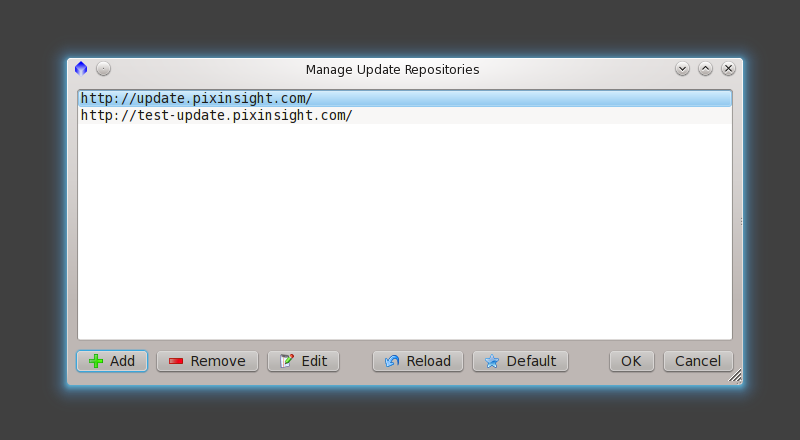
Checking for New Updates
By selecting the Resources > Updates > Check for Updates main menu option, PixInsight will check all selected repositories for new packages. New packages are those that haven't been installed yet and are applicable to your current version, platform and hardware architecture; PixInsight keeps track of all installed updates in an internal database that is maintained automatically by the update system.

Selecting and Downloading Updates
When the check for new updates is completed, there may be new updates available for you. When this happens, the Select and Download Updates dialog opens and allows you to select/unselect specific packages. This dialog provides extensive information on the repositories and all available packages. This information is provided by the package author(s) and should be complete enough as to keep you informed about the updates you are applying to your PixInsight installation.
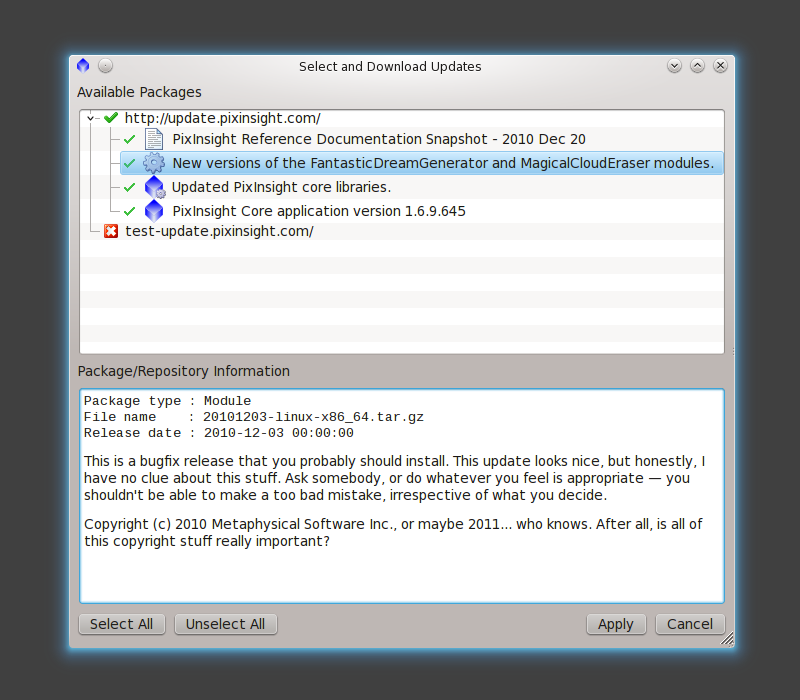
Once you have selected the desired updates (typically, all of them should be selected, especially all the updates available on the official PixInsight repository), you can click the Apply button to start dowloading packages.
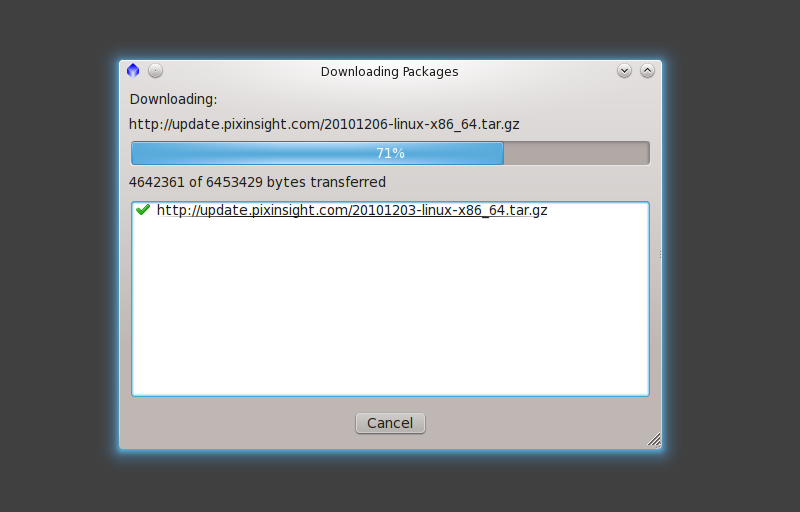
Update packages are downloaded to the location selected as the downloads directory on global preferences (Edit > Global Preferences > Directories and Network). By default, the downloads directory is the system temporary directory, but you can define it as any directory where you can create/remove/write files. If some of the packages that you have selected were already downloaded in a previous session (for example, because you had to abort the download process for any reason), they won't be downloaded again if the files are valid.
When you download a PixInsight Core application update, you must authenticate as a PixInsight user with your user name and password.
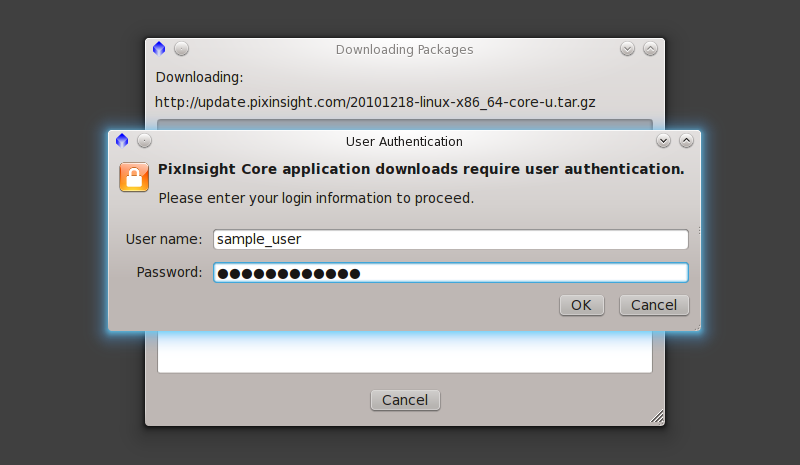
The user name and password that you must use here are not your user identifier and activation code that you used to activate your license. You must use the data of your account on our file servers, which are the same user name and password that you use to access our Software Distribution System.
Your authentication data and the core application packages travel strongly encrypted (double AES-256 encryption with entropy maximization, a custom protocol similar to SSH in some aspects) to protect your data transactions from possible listeners or other bad boys trying to redirect your connection to their own 'services'.
Once all packages have been downloaded, you get a report and a message telling that the updates will be installed when you exit PixInsight. You can also unschedule the update installation with the corresponding main menu item.

Update Installation
Installation of updates is performed when you exit the PixInsight Core application. A dialog box allows you to confirm or cancel the installation, along with selecting whether to relaunch the PixInsight Core application at the end of the process. If you choose not to restart PixInsight, the updates will be installed in the same way but some final steps will be carried out by the Core application the next time you run it.

If all went well, the PixInsight Core application will be relaunched, possibly updated/new modules and scripts will be installed and featured, respectively, and you'll see a dialog box like the following one:
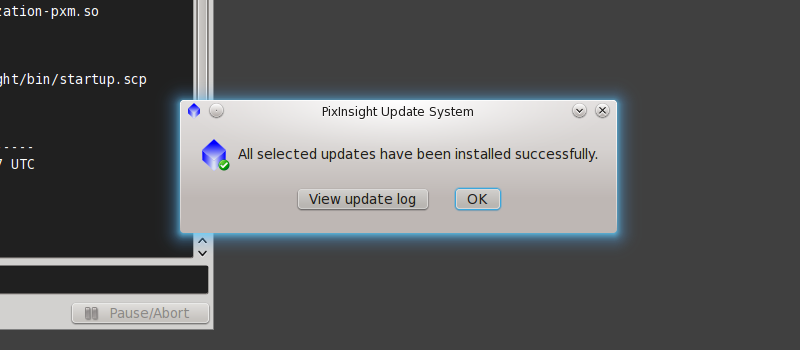
As an option, you can see the log file generated by the updater process. The log file provides exhaustive information about every file and directory that the updater has created, copied or removed on your system during the update installation task. This information can be of great help to diagnose/repair possible installation errors.
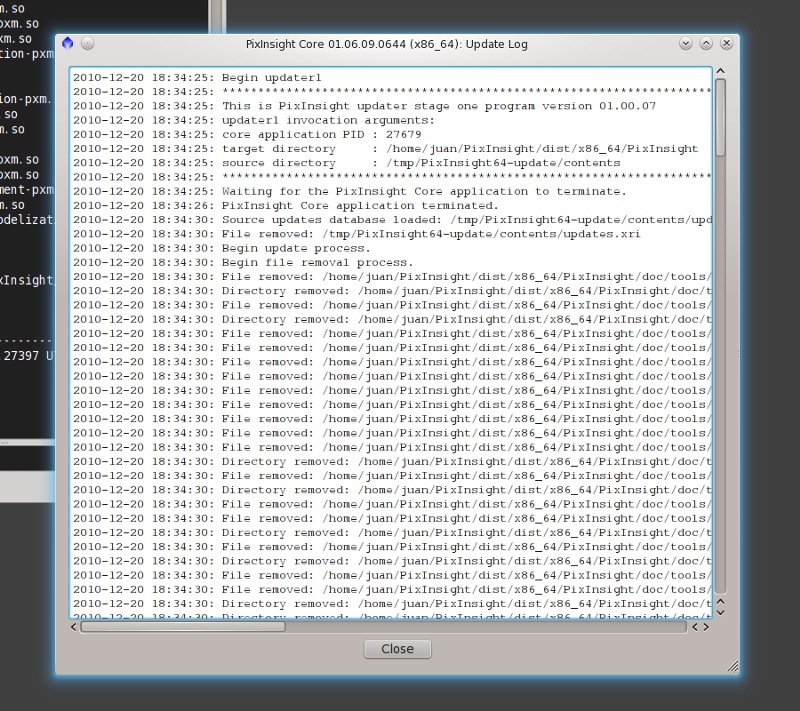
Software Updates and User Privileges
An important topic that must be carefully considered when designing a software update system is user access privileges. When PixInsight is installed on a system protected directory, the updater application must gain the required privileges. In the case of PixInsight, the policies applied are dependent on the operating system:
- Windows. PixInsight for Windows installs now on the standard Program Files folder by default. This is a protected directory requiring administrative privileges. The PixInsight Updater application uses the standard User Account Control (UAC) mechanism on Windows Vista and Windows 7 to request 'elevation' to the user upon execution. PixInsight Updater has been, as well as all executables and installation programs in all Windows distributions of PixInsight, digitally signed with an Authenticode certificate issued by VeriSign for Pleiades Astrophoto S.L.

- Mac OS X. On the Mac, we assume that the user has full write access on the /Applications folder, so the PixInsight Updater application requires no special permissions to work normally.
- FreeBSD and Linux. On these operating systems, the required permissions for the updater program depend on where PixInsight has been installed. If PixInsight has been installed on a directory under the user's $HOME directory, then no special permissions are required because the user already has full write access. However, if PixInsight has been installed under a system directory (for example, on /usr/local or usr/lib) the situation is completely different. In these cases the updater1 executable (which you'll find on the bin installation directory) requires a sticky SUID bit, which can only be set by root. This task will be performed automatically by the new UNIX/Linux installation program that will be released with the next version of PixInsight. For now, if you are interested in installing PixInsight manually in this way, let me know and we'll post a description of the required procedure on this forum.
While I'm writing this post, the last installation archives for PixInsight 1.6.9 are being uploaded to our file server, so the public release of this new version is imminent for all supported platforms: FreeBSD, Linux, Mac OS X and Windows, both 32-bit and 64-bit versions (only 64-bit for the FreeBSD release).
This version is actually a milestone in the history of PixInsight due to a significant new feature: the PixInsight Update System. You probably won't understand how important this feature is until you start receiving updates regularly with bug fixes, new tools and features, new documentation, etc., and you see them applied to your PixInsight installation automatically. The update system will change the whole PixInsight project dramatically, probably more than any other feature that we have implemented so far. From now on PixInsight will be really the dynamic and evolving platform that we have had in mind since the beginning, back in 2003.
Although the update system is quite complex internally (I must confess that I underestimated its complexity, and this has been one of the reasons for the delay in publishing a new version), I have made efforts to keep its user interface as simple and easy-to-use as possible, and I honestly think it is actually one of the most easy-to-use PixInsight tools I've designed
Automatic Check for Updates
Each time you run the PixInsight Core application, it initiates a "check for updates" routine automatically. This feature can be disabled via global preferences, but it is enabled by default. During the automatic update check process a PixInsight icon appears in the system icon tray. If there are no updates available, the icon is hidden silently, but if there are one or more updates available for your current PixInsight installation, a message box is shown similar to the next screenshot.

You can either click on the message window to review the updates, or right-click the system tray icon (left-click on Mac OS X) to select two relevant options from a context menu:

The update check routine can also be launched at any time from the new Resources > Updates menu. On this menu you have access to all of the functions that control the update system.

PixInsight Repositories
PixInsight updates are provided by PixInsight repositories. From the end user perspective, a repository is just the URL of a website that provides update packages, which are the basic elements managed by the update system. An update package is a compressed archive (in various formats, from standard tar.gz UNIX archives to 7-zip archives) whose contents can replace existing elements in the current PixInsight installation, add new elements, or remove existing ones (for example, there can be 'cleanup packages' that remove obsoleted or superseded features).
The user is free to add new repositories to the update system. The official PixInsight repository is maintained by Pleiades Astrophoto and its URL is:
http://update.pixinsight.com/
This is the default PixInsight repository and obviously where most PixInsight updates will be available for bug fixes, new versions of the Core application, new and improved standard modules, reference documentation, etc.
Third-party developers can --and I hope they will-- create their own repositories very easily. I'll describe the procedure to create a PixInsight repository in a new post. When a developer on the PixInsight/PCL or PJSR platforms creates a repository, (s)he should announce it on this forum --we are also glad to issue massive emails to announce new repositories to all PI users, so developers can count on us in this regard.
By selecting the Resources > Updates > Manage Repositories main menu option you can add, remove and edit repository URLs at your discretion:

Checking for New Updates
By selecting the Resources > Updates > Check for Updates main menu option, PixInsight will check all selected repositories for new packages. New packages are those that haven't been installed yet and are applicable to your current version, platform and hardware architecture; PixInsight keeps track of all installed updates in an internal database that is maintained automatically by the update system.

Selecting and Downloading Updates
When the check for new updates is completed, there may be new updates available for you. When this happens, the Select and Download Updates dialog opens and allows you to select/unselect specific packages. This dialog provides extensive information on the repositories and all available packages. This information is provided by the package author(s) and should be complete enough as to keep you informed about the updates you are applying to your PixInsight installation.

Once you have selected the desired updates (typically, all of them should be selected, especially all the updates available on the official PixInsight repository), you can click the Apply button to start dowloading packages.

Update packages are downloaded to the location selected as the downloads directory on global preferences (Edit > Global Preferences > Directories and Network). By default, the downloads directory is the system temporary directory, but you can define it as any directory where you can create/remove/write files. If some of the packages that you have selected were already downloaded in a previous session (for example, because you had to abort the download process for any reason), they won't be downloaded again if the files are valid.
When you download a PixInsight Core application update, you must authenticate as a PixInsight user with your user name and password.

The user name and password that you must use here are not your user identifier and activation code that you used to activate your license. You must use the data of your account on our file servers, which are the same user name and password that you use to access our Software Distribution System.
Your authentication data and the core application packages travel strongly encrypted (double AES-256 encryption with entropy maximization, a custom protocol similar to SSH in some aspects) to protect your data transactions from possible listeners or other bad boys trying to redirect your connection to their own 'services'.
Once all packages have been downloaded, you get a report and a message telling that the updates will be installed when you exit PixInsight. You can also unschedule the update installation with the corresponding main menu item.

Update Installation
Installation of updates is performed when you exit the PixInsight Core application. A dialog box allows you to confirm or cancel the installation, along with selecting whether to relaunch the PixInsight Core application at the end of the process. If you choose not to restart PixInsight, the updates will be installed in the same way but some final steps will be carried out by the Core application the next time you run it.

If all went well, the PixInsight Core application will be relaunched, possibly updated/new modules and scripts will be installed and featured, respectively, and you'll see a dialog box like the following one:

As an option, you can see the log file generated by the updater process. The log file provides exhaustive information about every file and directory that the updater has created, copied or removed on your system during the update installation task. This information can be of great help to diagnose/repair possible installation errors.

Software Updates and User Privileges
An important topic that must be carefully considered when designing a software update system is user access privileges. When PixInsight is installed on a system protected directory, the updater application must gain the required privileges. In the case of PixInsight, the policies applied are dependent on the operating system:
- Windows. PixInsight for Windows installs now on the standard Program Files folder by default. This is a protected directory requiring administrative privileges. The PixInsight Updater application uses the standard User Account Control (UAC) mechanism on Windows Vista and Windows 7 to request 'elevation' to the user upon execution. PixInsight Updater has been, as well as all executables and installation programs in all Windows distributions of PixInsight, digitally signed with an Authenticode certificate issued by VeriSign for Pleiades Astrophoto S.L.

- Mac OS X. On the Mac, we assume that the user has full write access on the /Applications folder, so the PixInsight Updater application requires no special permissions to work normally.
- FreeBSD and Linux. On these operating systems, the required permissions for the updater program depend on where PixInsight has been installed. If PixInsight has been installed on a directory under the user's $HOME directory, then no special permissions are required because the user already has full write access. However, if PixInsight has been installed under a system directory (for example, on /usr/local or usr/lib) the situation is completely different. In these cases the updater1 executable (which you'll find on the bin installation directory) requires a sticky SUID bit, which can only be set by root. This task will be performed automatically by the new UNIX/Linux installation program that will be released with the next version of PixInsight. For now, if you are interested in installing PixInsight manually in this way, let me know and we'll post a description of the required procedure on this forum.
